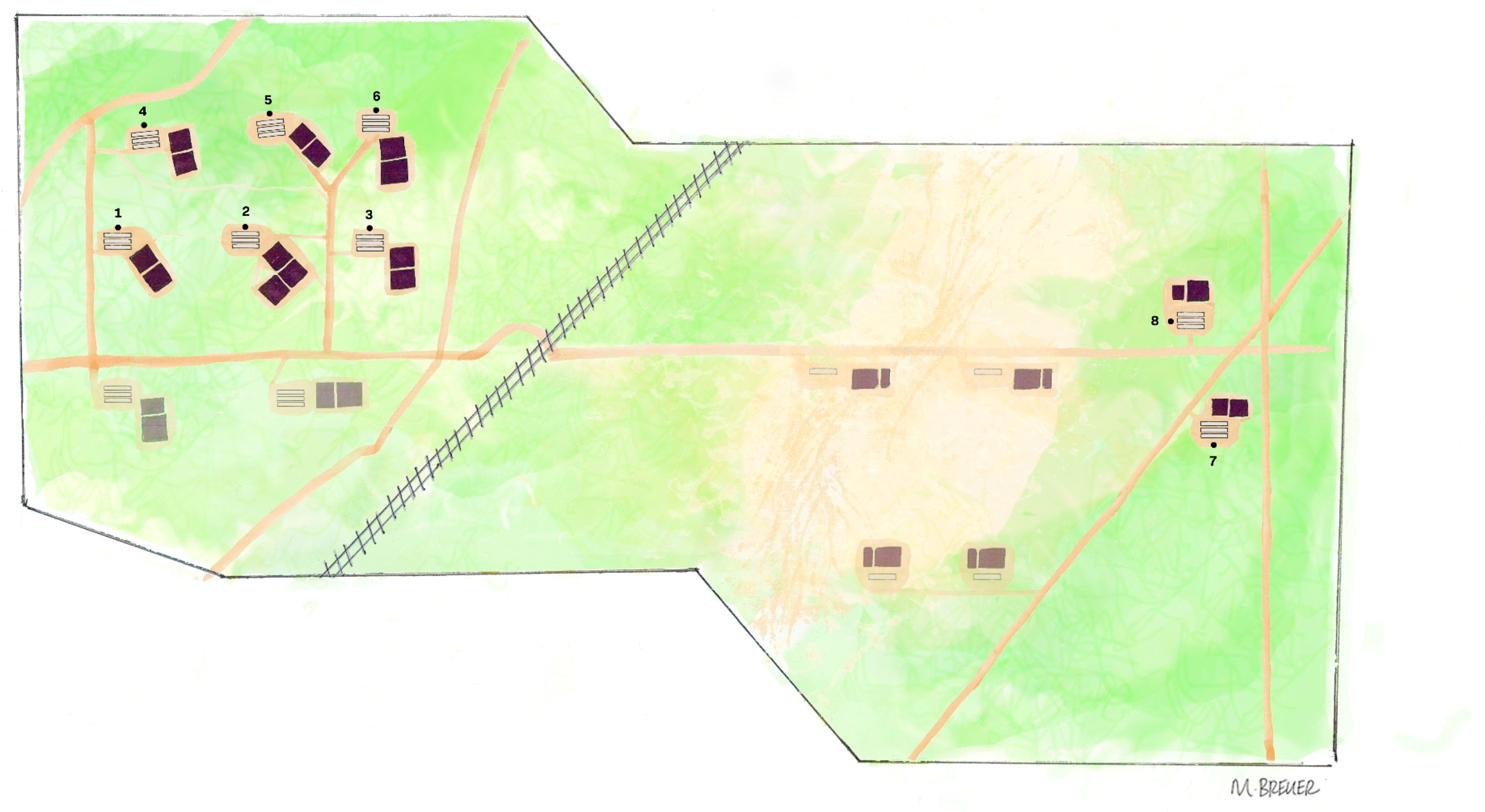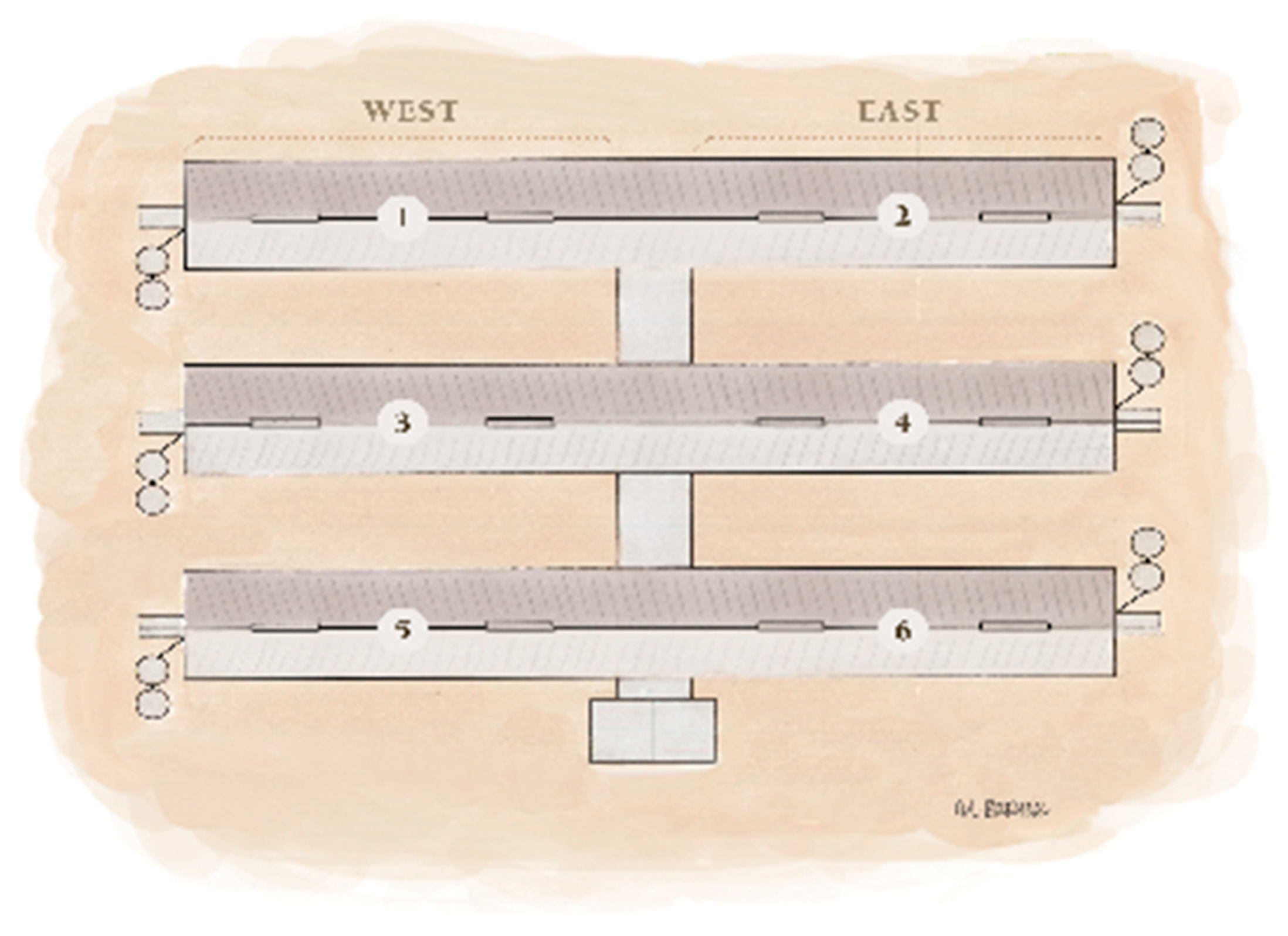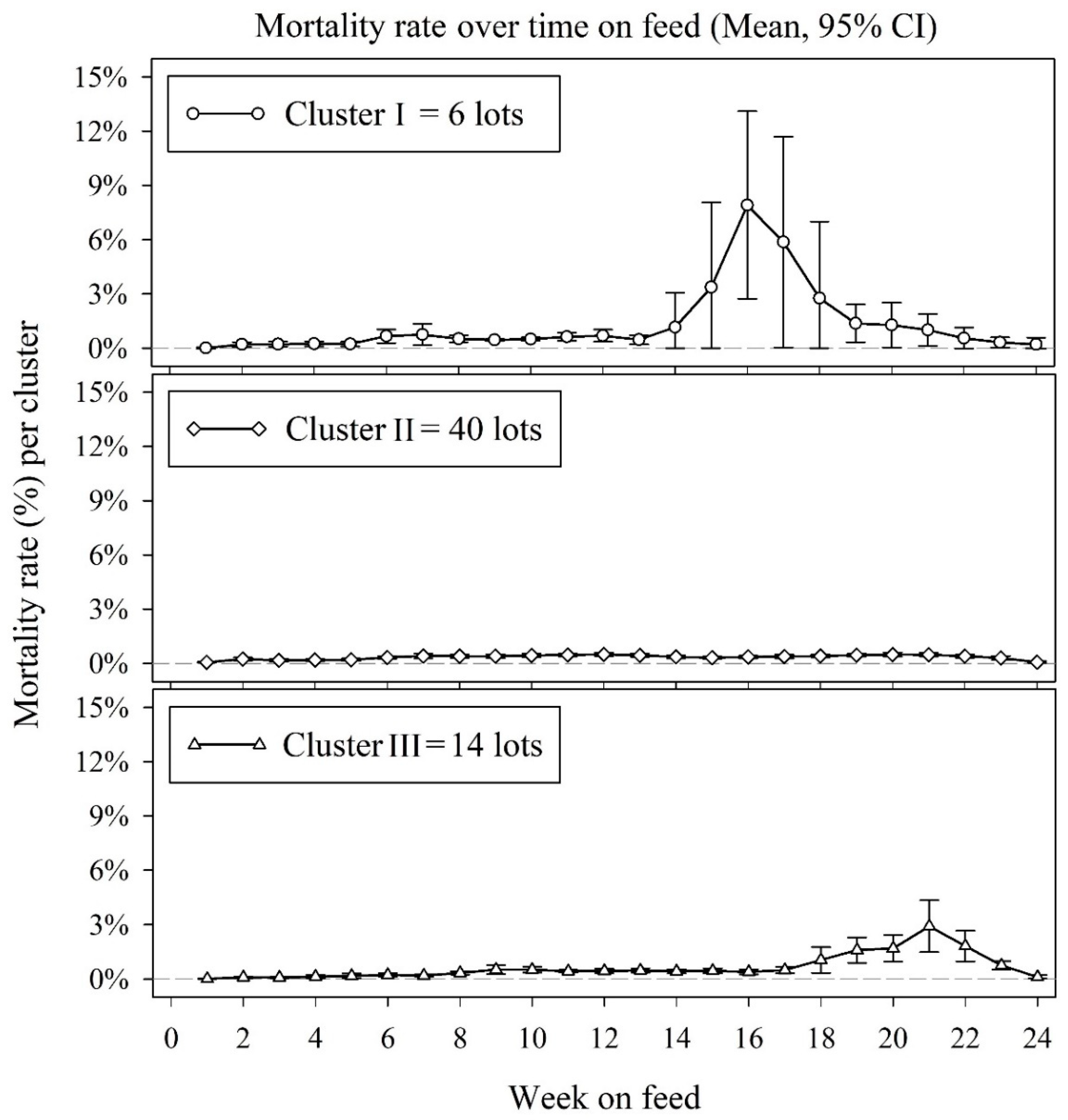Mortality Patterns in a Commercial Wean-To Finish Swine Production System
Abstract
1. Introduction
2. Materials and Methods
2.1. Experimental Design
2.2. Animals, Animal Care, and Management
2.3. Site Configuration
2.4. Phase Cost Calculations per Cluster
2.5. Profit/loss Calculations per Cluster
2.6. Statistical Analysis
3. Results
3.1. Creation of Mortality Clusters
3.2. Production and Cost Analysis
Model Adjustments
3.3. Cluster Management Data Characteristics
4. Discussion
Author Contributions
Conflicts of Interest
References
- Jones, J.E. The incidence and nature of diseaess causing death in pigs aged 2–7 months in a commercial herd. Br. Vet. J. 1969, 125, 492–503. [Google Scholar] [CrossRef]
- Ramirez, A.; Wang, C.; Prickett, J.R.; Pogranichniy, R.; Yoon, K.-J.; Main, R.; Johnson, J.K.; Rademacher, C.; Hoogland, M.; Hoffmann, P.; Kurtz, A.; et al. Efficient surveillance of pig populations using oral fluids. Prev. Vet. Med. 2012, 104, 292–300. [Google Scholar] [CrossRef] [PubMed]
- Maes, D.; Larriestra, A.; Deen, J.; Morrison, R. A retrospective study of mortality in grow-finish pigs in a multi-site production system. J. Swine Health Prod. 2001, 9, 267–273. [Google Scholar]
- Maes, D.G.D.; Duchateau, L.; Larriestra, A.; Deen, J.; Morrison, R.B.; Kruif, A. Risk Factors for Mortality in Grow-finishing Pigs in Belgium. J. Vet. Med. B 2004, 51, 321–326. [Google Scholar] [CrossRef] [PubMed]
- Larriestra, A.J.; Maes, D.G.; Deen, J.; Morrison, R.B. Mixed models applied to the study of variation of grower-finisher mortality and culling rates of a large swine production system. Can. J. Vet. Res. 2005, 69, 26–31. [Google Scholar] [PubMed]
- Larriestra, A.J.; Wattanaphansak, S.; Neumann, E.J.; Bradford, J.; Morrison, R.B.; Deen, J. Pig characteristics associated with mortality and light exit weight for the nursery phase. Can. Vet. J. 2006, 47, 560–566. [Google Scholar] [PubMed]
- DeDecker, J.M.; Ellis, M.; Wolter, B.F.; Corrigan, B.P.; Curtis, S.E.; Hollis, G.R. Effect of stocking rate on pig performance in a wean-to-finish production system. Can. J. Anim. Sci. 2005, 85, 1–5. [Google Scholar] [CrossRef]
- Main, R.G.; Dritz, S.S.; Nelssen, J.L.; Tokach, M.D.; Goodband, R.D. Increasing weaning age improves pig performance in a multisite production system. J. Anim. Sci. 2004, 82, 1499–1507. [Google Scholar] [CrossRef] [PubMed]
- Cho, J.H.; Kim, I.H. Effect of stocking density on pig production. Afr. J. Biotechnol. 2011, 10, 13688–13692. [Google Scholar]



| Site | Lots Per Barn | No. Pens | Pen Dimensions (m) | m2 per Pen | m2 per Barn |
|---|---|---|---|---|---|
| 1–6, 8 | 1 | 46 | 1268.61 | ||
| Housing pens | 42 | 4.98 × 5.79 | 28.83 | 1211.04 | |
| Treatment pens | 4 | 4.98 × 2.89 | 14.39 | 57.57 | |
| 7 | 1 | 38 | 1271.40 | ||
| Housing pens | 34 | 6.1 × 5.79 | 35.32 | 1200.88 | |
| Treatment pens | 4 | 6.1 × 2.89 | 17.63 | 70.52 |
| Phase | Placement | Nursery | Early Finishing | Finishing |
|---|---|---|---|---|
| Weeks in Phase | 1–4 | 5–8 | 9–12 | 13–24 |
| Cluster I | 0.02% | 2.18% | 2.28% | 23.87% |
| Cluster II | 0.69% | 1.37% | 1.81% | 4.49% |
| Cluster III | 0.29% | 0.88% | 1.86% | 11.43% |
| Diet | Cost/kg | Exp kg ADG | Exp FCR | Days | Exp kg ADFI | Exp kg Gained | Exp kg Cum Wt | Diet Cost per Head |
|---|---|---|---|---|---|---|---|---|
| N1 | $0.4134 | 0.36 | 1.45 | 9 | 0.53 | 3.27 | 10.40 | $1.958 |
| N2 | $0.3307 | 0.43 | 1.65 | 14 | 0.71 | 6.03 | 16.43 | $3.292 |
| N3 | $0.1929 | 0.57 | 1.90 | 14 | 1.08 | 7.94 | 24.37 | $2.909 |
| F1 | $0.1653 | 0.70 | 2.10 | 21 | 1.48 | 14.76 | 39.14 | $5.127 |
| F2 | $0.1450 | 0.79 | 2.48 | 30 | 1.95 | 23.61 | 62.75 | $8.471 |
| F3 | $0.1361 | 0.87 | 3.05 | 31 | 2.64 | 26.86 | 89.60 | $11.155 |
| F4 | $0.1207 | 0.79 | 3.73 | 74 | 2.96 | 30.96 | 148.34 | $26.426 |
| Phase | Diet | Days | Exp kg ADFI | Exp kg Gain | Exp kg Cum Wt | FC | FC/Phase |
|---|---|---|---|---|---|---|---|
| Placement | N1 | 9 | 0.53 | 3.27 | 10.40 | $1.96 | $6.29 |
| N2 | 14 | 0.71 | 6.03 | 16.43 | $3.29 | ||
| N3 | 5 | 1.08 | 2.83 | 19.27 | $1.04 | ||
| Nursery | N5 | 9 | 1.08 | 5.10 | 24.37 | $1.87 | $6.51 |
| F1 | 19 | 1.48 | 13.36 | 37.73 | $4.64 | ||
| Early Fin | F1 | 2 | 1.48 | 1.41 | 39.14 | $0.49 | $17.60 |
| F2 | 30 | 1.95 | 23.61 | 62.75 | $8.47 | ||
| F3 | 24 | 2.64 | 20.79 | 83.54 | $8.64 | ||
| Late Fin | F3 | 7 | 2.64 | 6.06 | 89.60 | $2.23 | $28.94 |
| F4 | 74 | 2.96 | 53.18 | 148.34 | $26.43 |
| Diet | Cost/kg | Exp kg ADG | Exp FCR | Exp Days on Diet | Exp ADFI, kg | Exp kg Gained | ExpCumWt, kg | $Diet/Pig | ADG Factor |
|---|---|---|---|---|---|---|---|---|---|
| N3 | $0.4134 | 0.36 | 1.45 | 9 | 0.53 | 3.27 | 10.40 | $1.958 | 1.00 |
| N4 | $0.3307 | 0.43 | 1.65 | 14 | 0.71 | 6.03 | 16.43 | $3.292 | 1.00 |
| N5 | $0.1929 | 0.57 | 1.90 | 14 | 1.08 | 7.94 | 24.37 | $2.909 | 1.00 |
| F1 | $0.1653 | 0.69 | 2.10 | 21 | 1.48 | 14.03 | 38.84 | $5.127 | 0.98 |
| F2 | $0.1450 | 0.77 | 2.48 | 30 | 1.95 | 22.43 | 61.98 | $8.471 | 0.98 |
| F3 | $0.1361 | 0.43 | 3.05 | 31 | 2.64 | 13.43 | 75.41 | $11.155 | 0.50 |
| F4 | $0.1207 | 0.39 | 3.73 | 39 | 2.96 | 15.17 | 90.58 | $13.927 | 0.49 |
| Phase | Mortality | Diet | Days | Exp ADFI, kg | Exp kg Gained | Exp kg End wt | FC | FC/Phase |
|---|---|---|---|---|---|---|---|---|
| Placement | 0.02% | N3 | 9 | 0.53 | 3.27 | 10.40 | $1.96 | $6.29 |
| N4 | 14 | 0.71 | 6.03 | 16.43 | $3.29 | |||
| N5 | 5 | 1.08 | 2.83 | 19.27 | $1.04 | |||
| Nursery | 2.18% | N5 | 9 | 1.08 | 5.10 | 24.37 | $1.87 | $6.51 |
| F1 | 19 | 1.48 | 12.69 | 37.06 | $4.64 | |||
| Early Fin | 2.28% | F1 | 2 | 1.48 | 1.34 | 38.40 | $0.49 | $17.60 |
| F2 | 30 | 1.95 | 22.43 | 60.83 | $8.47 | |||
| F3 | 24 | 2.64 | 10.40 | 71.22 | $8.64 | |||
| Late Fin | 23.87% | F3 | 7 | 2.64 | 3.03 | 74.26 | $2.52 | $35.37 |
| F4 | 92 | 2.96 | 35.78 | 110.04 | $32.85 |
| Placement | Nursery | Early Finishing | Late Finishing | |||||
|---|---|---|---|---|---|---|---|---|
| ADG | FCR | ADG | FCR | ADG | FCR | ADG | FCR | |
| Cluster I | 0.73 | 2.17 | 1.1 | 2.69 | 1.37 | 3.58 | 1.34 | 4.81 |
| Cluster II | 0.94 | 1.69 | 1.42 | 2.09 | 1.77 | 2.78 | 1.74 | 3.69 |
| Cluster II | 0.82 | 1.94 | 1.24 | 2.39 | 1.54 | 3.19 | 1.51 | 4.26 |
| Phase | n | Placement FC | Nursery FC | Early Finishing FC | Late Finishing FC | Total FC |
|---|---|---|---|---|---|---|
| Cluster I | 6 | $3.19 | $3.28 | $8.32 | $12.59 | $27.38 |
| Cluster II | 40 | $4.69 | $4.85 | $12.95 | $12.13 | $34.62 |
| Cluster III | 14 | $3.95 | $4.10 | $10.88 | $13.69 | $32.62 |
| Total NDP | Total Pigs Marketed | Total Revenue per Pig Placed | Total Expense per Pig Placed | Total Profit per Pig Placed | |
|---|---|---|---|---|---|
| Cluster I | 304 | 696 | $93.48 | $106.53 | –$13.05 |
| Cluster II | 56 | 914 | $126.72 | $115.18 | $11.54 |
| Cluster III | 138 | 862 | $117.84 | $113.57 | $4.27 |
| n | Avg. Starting Weight, kg | Head Placed | Capacity Placed | m2/Pig | Avg. Total NDP | Average Cluster Mortality | Avg. Market Weight, kg | |
|---|---|---|---|---|---|---|---|---|
| Cluster I | 6 | 7.14 a | 2046 c | 1.11 e | 0.6197 g | 568 | 27.6 a | 110.22 |
| Cluster II | 40 | 6.61 b | 1864 d | 0.98 f | 0.6856 h | 152 | 8.1 b | 118.39 |
| Cluster III | 14 | 7.15 a | 2026 c | 1.06 e | 0.6271 g | 286 | 14.2 a | 116.12 |
© 2019 by the authors. Licensee MDPI, Basel, Switzerland. This article is an open access article distributed under the terms and conditions of the Creative Commons Attribution (CC BY) license (http://creativecommons.org/licenses/by/4.0/).
Share and Cite
Mehling, S.; Henao-Diaz, A.; Maurer, J.; Kluber, E.; Stika, R.; Rademacher, C.; Zimmerman, J.; Giménez-Lirola, L.; Wang, C.; Holtkamp, D.J.; et al. Mortality Patterns in a Commercial Wean-To Finish Swine Production System. Vet. Sci. 2019, 6, 49. https://doi.org/10.3390/vetsci6020049
Mehling S, Henao-Diaz A, Maurer J, Kluber E, Stika R, Rademacher C, Zimmerman J, Giménez-Lirola L, Wang C, Holtkamp DJ, et al. Mortality Patterns in a Commercial Wean-To Finish Swine Production System. Veterinary Sciences. 2019; 6(2):49. https://doi.org/10.3390/vetsci6020049
Chicago/Turabian StyleMehling, Samantha, Alexandra Henao-Diaz, Jeremy Maurer, Ed Kluber, Rachel Stika, Christopher Rademacher, Jeff Zimmerman, Luis Giménez-Lirola, Chong Wang, Derald J. Holtkamp, and et al. 2019. "Mortality Patterns in a Commercial Wean-To Finish Swine Production System" Veterinary Sciences 6, no. 2: 49. https://doi.org/10.3390/vetsci6020049
APA StyleMehling, S., Henao-Diaz, A., Maurer, J., Kluber, E., Stika, R., Rademacher, C., Zimmerman, J., Giménez-Lirola, L., Wang, C., Holtkamp, D. J., Main, R., Karriker, L., Linhares, D. C. L., Breuer, M., Goodell, C., & Baum, D. (2019). Mortality Patterns in a Commercial Wean-To Finish Swine Production System. Veterinary Sciences, 6(2), 49. https://doi.org/10.3390/vetsci6020049






